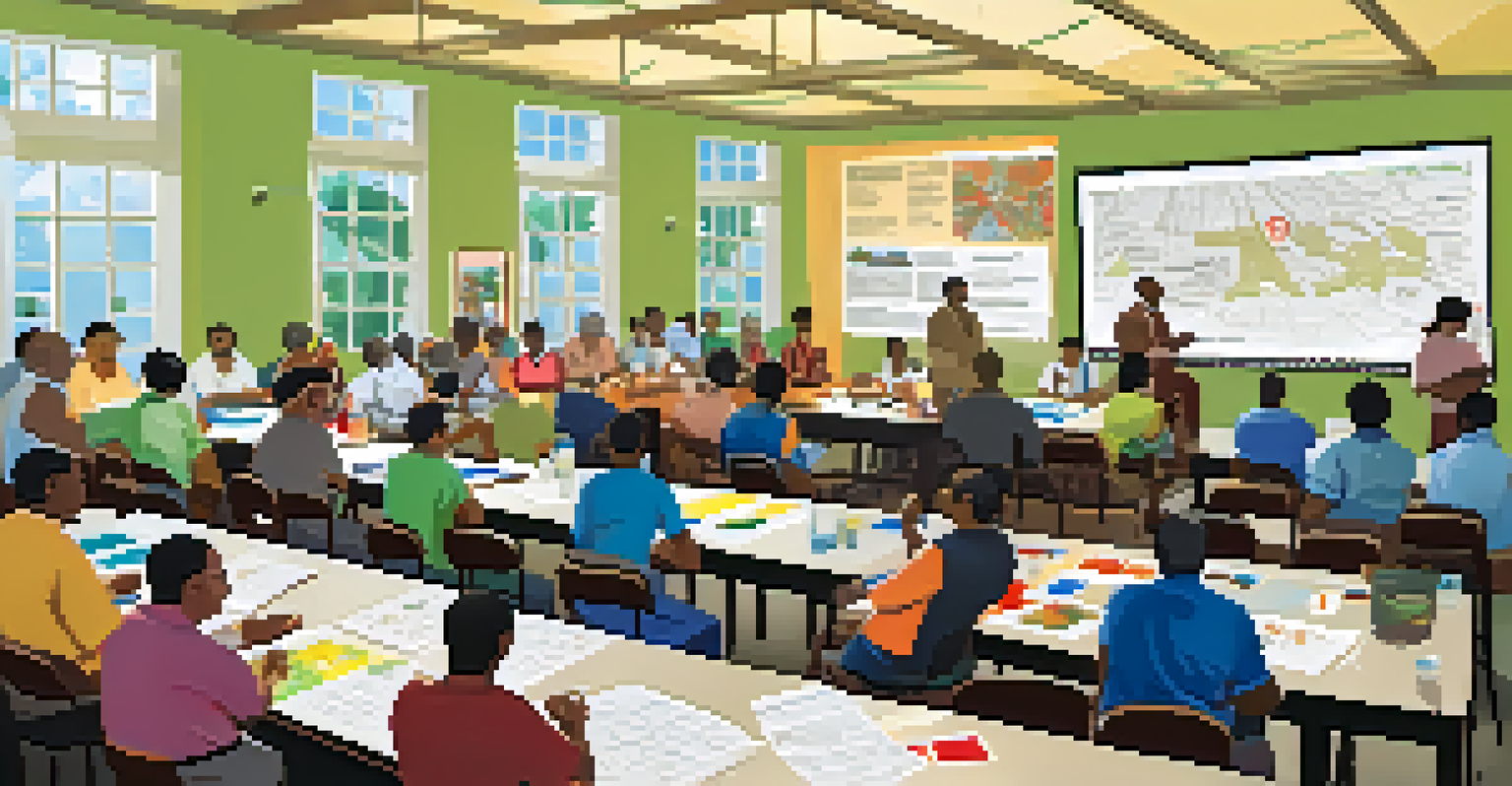Assessing Vulnerabilities in Urban Disaster Management

Understanding Urban Vulnerabilities in Disaster Scenarios
Urban areas face unique vulnerabilities during disasters due to their dense populations and complex infrastructures. Understanding these vulnerabilities is critical for effective disaster management strategies. For instance, a city that relies heavily on public transportation may struggle more during a flood, as many people depend on buses and trains to evacuate.
Disasters don't have to be devastating. With the right planning and preparation, we can mitigate their impact and build resilient communities.
In addition to infrastructure, socioeconomic factors play a significant role in vulnerability. Low-income communities often lack resources to prepare for and recover from disasters. This disparity highlights the need for tailored strategies that address the specific needs of vulnerable populations.
Ultimately, recognizing the different types of vulnerabilities—be they physical, social, or economic—allows urban planners and disaster management professionals to develop more effective responses to disasters. This comprehensive understanding can lead to better resource allocation and more resilient communities.
The Role of Risk Assessment in Urban Planning
Risk assessment is an essential tool in urban planning that helps identify potential hazards and the likelihood of their occurrence. By conducting thorough risk assessments, urban planners can prioritize areas that are most at risk and develop targeted strategies to mitigate those risks. For example, mapping flood-prone areas enables cities to implement better drainage systems.

Moreover, risk assessments can guide the allocation of resources before, during, and after a disaster. By understanding where vulnerabilities lie, city officials can focus their efforts on the most critical areas, ensuring that help reaches those who need it most. This strategic approach can significantly enhance urban resilience.
Urban Vulnerabilities in Disasters
Dense populations and socioeconomic factors significantly impact how urban areas respond to disasters.
Involving community members in the risk assessment process also fosters collaboration and trust. When residents contribute their insights, planners gain a clearer picture of the vulnerabilities faced by different neighborhoods, leading to more effective and inclusive disaster management strategies.
Community Engagement: A Key Component of Disaster Management
Community engagement is vital in assessing vulnerabilities within urban disaster management plans. When communities are actively involved, they can share their unique experiences and insights, which can inform more effective disaster preparedness strategies. This collaborative approach empowers residents and enhances their sense of ownership over their safety.
The greatest gift is not being afraid to question.
For example, holding community workshops or forums can provide a platform for residents to voice their concerns and suggest solutions. This dialogue not only helps identify local vulnerabilities but also builds relationships among community members, which can be crucial during a disaster.
Furthermore, fostering a culture of preparedness through community engagement can lead to quicker recovery times. When residents are educated about disaster preparedness, they are more likely to take proactive measures, ensuring that the community is better equipped to handle emergencies.
Technology's Impact on Urban Disaster Management
Technology plays a transformative role in assessing vulnerabilities and improving urban disaster management. From advanced modeling tools that predict disaster impacts to mobile applications that keep residents informed, technology enhances preparedness and response efforts. For instance, real-time data can help city officials make informed decisions during a crisis.
Moreover, Geographic Information Systems (GIS) allow planners to visualize vulnerabilities and plan accordingly. By mapping out areas at risk, cities can prioritize interventions and allocate resources effectively. This data-driven approach leads to more efficient disaster management strategies.
Community Engagement is Essential
Involving residents in disaster management enhances preparedness and fosters a sense of ownership over community safety.
However, reliance on technology also comes with challenges, such as ensuring equitable access to information. It’s essential that all community members, regardless of socioeconomic status, have access to technological resources that can aid in disaster preparedness and response.
Building Resilient Urban Infrastructure
Investing in resilient infrastructure is crucial for minimizing vulnerabilities in urban areas during disasters. This includes upgrading transportation systems, enhancing buildings to withstand extreme weather, and improving drainage systems to prevent flooding. Resilient infrastructure not only protects communities but also ensures quicker recovery after a disaster.
For example, cities can implement green infrastructure solutions, such as parks and green roofs, which can absorb rainwater and reduce flooding. These sustainable practices not only mitigate risks but also improve the overall quality of urban life.
Furthermore, resilience planning should involve regular assessments and updates to infrastructure projects. As climate change continues to pose new threats, cities must adapt and evolve their infrastructure strategies to meet emerging challenges.
Policy Development for Effective Disaster Management
Effective disaster management requires robust policies that address urban vulnerabilities. Policymakers must create frameworks that prioritize disaster preparedness, response, and recovery. By establishing clear guidelines and protocols, cities can ensure a coordinated approach during emergencies.
Additionally, policies should promote collaboration among various stakeholders, including government agencies, non-profits, and community organizations. This collaborative effort not only enhances resource sharing but also fosters a sense of collective responsibility for disaster management.
Technology Enhances Disaster Strategies
Utilizing technology, such as GIS and real-time data, improves urban disaster management by aiding in vulnerability assessment and response planning.
Regular policy evaluations are also essential to adapt to shifting vulnerabilities and emerging threats. By staying informed and responsive, policymakers can create dynamic strategies that effectively address the unique challenges of urban disaster management.
The Importance of Continuous Training and Education
Continuous training and education for city officials and community members are vital in effective urban disaster management. Regular training sessions equip responders with the latest strategies and technologies to handle emergencies effectively. This preparedness can make a significant difference during actual disasters.
Moreover, educating the public about disaster risks and preparedness encourages a culture of readiness. When community members understand potential hazards and know how to respond, they are more likely to act quickly and effectively when a disaster strikes.

Incorporating simulations and drills into training programs can also enhance preparedness. These hands-on experiences allow participants to practice their skills and improve coordination among different response teams, ultimately leading to a more resilient urban environment.
Evaluating and Improving Urban Disaster Management Systems
Evaluating existing disaster management systems is crucial for identifying strengths and weaknesses. By conducting assessments after a disaster, cities can learn valuable lessons and make necessary adjustments to their plans. This continuous improvement cycle leads to a more effective response in future emergencies.
Engaging with community feedback post-disaster is also essential. Residents often have firsthand experiences that can illuminate areas for improvement in disaster management strategies. This feedback loop creates a sense of community involvement and encourages collective action.
Ultimately, the goal of evaluating urban disaster management systems is to create a safer, more resilient environment for all residents. By learning from past experiences and adapting to new challenges, cities can better protect their communities from the impacts of disasters.